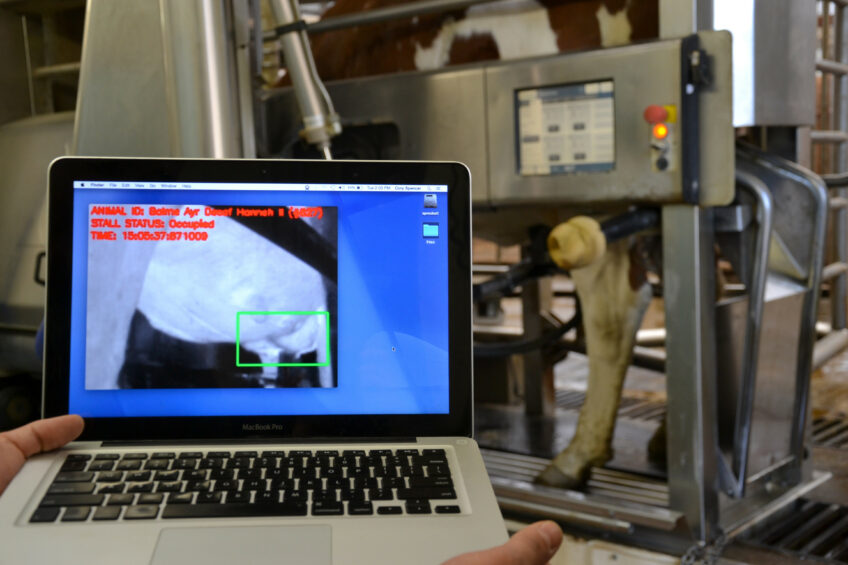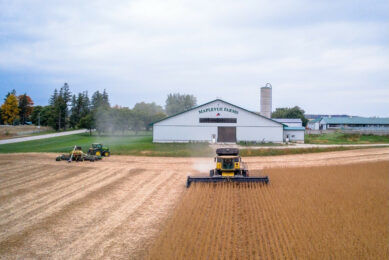Udder health score in less than a minute

Healthy udders is one of the most vital management tools in maintaining a profitable dairy farm. Detecting udder infections early is key and can save farmers a lot of money.
Udder infections are costing dairy farmers across the world around €8.61 billion ($10 billion) a year in lost production with smaller farms with less technology suffering the most.
A Canadian company is now focusing on addressing the issue with its own detection system that is not only accurate, but affordable. EIO Diagnostics has come up with a new system that scans udders in the parlour, either via a mounted scanner in robotic milking systems or a handheld device, and relays the images to a screen where infections can be identified easier. EIO claim its solution detects these infections dramatically sooner, and cheaper, than any other approach currently on the market. The company uses a technique known as multispectral imaging which detects udder abnormalities as they form.

Testing udder health in under a minute
Animals’ affected by harmful pathogens, even at Somatic Cell Count (SCC) levels which are generally considered sub-clinical, can now be identified by farmers.
Being able to identify a Staphylococcus aureus infection, even when a standard SCC test is showing levels below 200,000 SCC, gives farmers an effective tool for increasing herd health and minimising production losses. The handheld device, which is about the size and shape of a small tablet, can tell the health of an udder in less than one second.
Used in bigger automated milking parlours the mounted device identifies and monitors cows as they enter the milking stall or robot. It integrates with DeLaval VMS or Lely Astronaut robotic milkers and can also be integrated with automated feeders, leveraging existing animal identification systems.

Measuring the actual infection
The brains behind the detection system is Cory Spencer, who started EIO off in the barns of his The Happy Goat Cheese Company, in the Cowichan Valley, Canada. Cory is a full stack developer and goat cheese maker, and had experienced a mastitis problem with one of his goats. Along with his fellow rural-living tech neighbour Damir Wallener, a proof of concept solution was brought to life over the spring and summer seasons of 2017.
Damir is the chief executive officer of EIO and said the interest the company is receiving from farmers indicates their system is quite unique. He said: “From the intense interest we are receiving from actual dairy farmers, the answer has to be no, there are no similar systems on the market. There are automated SCC and electroconductivity devices available, but they share the problem of trying to identify udder infections by measuring something indirectly related to the actual infections. No other product also works with dry cows or pre-calving animals that don’t regularly pass through the milking parlour.”
Prices on a service model
The EIO Diagnostics system is currently being tested in several commercial dairy barns on Vancouver Island, using both goats and cows. The company is also preparing for its first large scale deployments, one in New Zealand and one in Wisconsin. EIO say it prices the system on a service model rather than individual hardware sales and each system will differ on the number of scanners required. “It very much depends on the usage model and milking parlour style,” said Damir. “For the same size herd, a rotary milking platform needs fewer devices than, for example, a double 12. From the dairy’s perspective, though, it all works out the same, as EIO prices on a service model rather than a hardware sales model. EIO manages all the hardware, software, updates and maintenance, for a fixed price, with no surprises. For goat dairies, the pricing is $3 (£2.29) per month, per goat. For cows, it is $5 (£3.82) per month, per cow. From the farm’s perspective, by reducing per-animal lab tests, or saving just one bulk tank from being dumped, the service pays for itself very quickly.”
Once the device visualises an udder, it takes a number of measurements from various parts of the spectrum. These are run through a complex mathematical model, generating a pass or fail signal. “This takes less than a second,” said Damir. “The measurements are also pushed to EIO’s software cloud, where they are combined with all the other imaging done at all the other barns. Over time, improved models are pushed back down to the devices, allowing every farm to learn from what is happening on every other farm.” The system can send emails, text messages, and it can use messaging apps like Slack or update a cloud-based dashboard. Basically, any internet-dependent communication channel is either supported, or easy for us to add.

First commercial deployments
Unfortunately for farmers, current approaches based on SCC and electroconductivity generate high false positive rates, so the standard is quite low.
Damir: “Over the next couple of months, in partnership with a highly regarded university dairy science program, we will publish fully quantified results showing how well our detection matches up with actual pathogen tests. The system is in commercial deployment with select customers. Our core motivation as a company is to ‘make something people love,’ so it is important for us at this stage to not take on more than we can properly manage.” Right now the company has the capacity for perhaps 2 or 3 more customers, with general release planned for fall of 2018. The beta and test farm deployments are in Canada. The first commercial deployments, happening right now, are in New Zealand and the United States. “As those come to life, we will be looking for our first EU deployment, and then working with NGOs to bring this solution to small-herd farmers in Africa,” Damir added.
Join 13,000+ subscribers
Subscribe to our newsletter to stay updated about all the need-to-know content in the dairy sector, two times a week.










